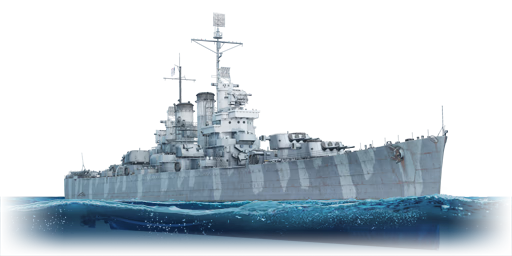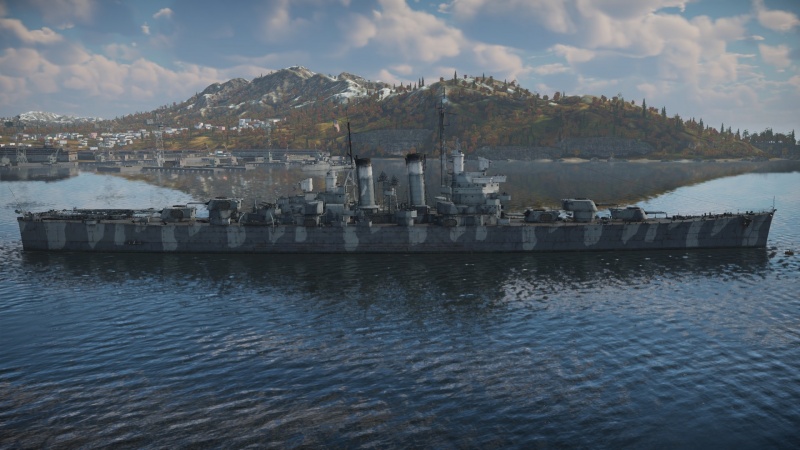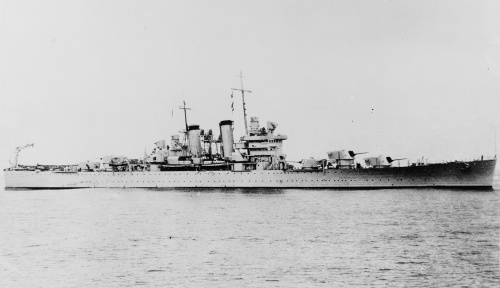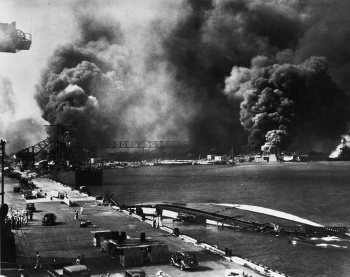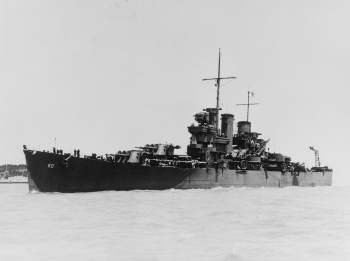USS Helena
Contents
Description
The Brooklyn-class, USS Helena (CL-50), 1943 was the ninth and last built Brooklyn-class light cruiser. She was laid down on 9th December 1936 and commissioned on 18th September 1939. Her main armament was made up of five triple 6 inch/47 Mk.16 cannons supplemented by four twin 5 inch/38 Mk.12 dual-purpose cannons. Anti-aircraft protection was supplied by four quadruple 40 mm Bofors L/60 Mark 2 cannons and twelve 20 mm Oerlikon Mk. II autocannons. During the attack on Pearl Harbor, she was torpedoed and had to be repaired. During the repair, she also underwent refit. She returned to service in 1942 to participate in the Guadalcanal campaign. On the night between 11th and 12th October, during the Battle of Cape Esperance, Helena detected Japanese ships 25 km away. Due to an error in leadership of the US Navy commander in charge of the task force, they closed to 4,500 m before Helena opened fire, followed by Boise, Salt Lake City, and San Francisco. The Japanese heavy cruiser Furutaka was sunk together with destroyer Fubuki. On 13th November 1942, Helena took part in the Third and Fourth Battle of Savo Island during which the US Navy was outnumbered by their Japanese counterpart. Two Atlanta-class light cruisers were lost together with four destroyers. Japan lost a Kongo-class battleship and two destroyers. During the battle, Helena crippled Japanese destroyer Amatsukaze that tried to sneak up on her to launch torpedoes. After Guadalcanal, she participated in the Solomon Islands landings. On 5th July 1943, during the Battle of Kula Gulf, Helena sunk destroyer Niizuki and later was torpedoed by two Japanese destroyers. The damage from the torpedoes proved fatal and Helena sank.
It was introduced in Update 1.93 "Shark Attack" purchasable in-game with Golden Eagles ![]() . Helena is quite sturdy ship capable of causing heavy damage due to high amount of barrels and very fast reload of only 6 seconds. The ship itself is fast and manoeuvrable, although not very armoured. Anti-fragmentation armour inside of the ship further decreases shrapnel damage caused to modules and crew.
. Helena is quite sturdy ship capable of causing heavy damage due to high amount of barrels and very fast reload of only 6 seconds. The ship itself is fast and manoeuvrable, although not very armoured. Anti-fragmentation armour inside of the ship further decreases shrapnel damage caused to modules and crew.
The USS Helena was available in the store in a premium pack until it was removed after the 9th Anniversary Sale, but was later re-introduced as a regular in-game premium for ![]() .
.
General info
Survivability and armour
Armour on Helena is pretty strong for a light cruiser, as it can definitely hold out against large calibre HE shells. One should remember that Brooklyn-class cruisers oftentimes could survive a torpedo hit, so if you have enough crew, you can easily tank one or even two torpedoes. Your main concern while playing Helena should be high calibre AP shells, as they can wreck your ship in no time, especially if they are coming from fast reloading guns like American 5"/38, or if they are shot at you by a ship with lots of guns like IJN Suzuya.
Turret face armour is 165 mm, side, rear and top armour are 76 mm, 76 mm, and 51 mm thick respectively, and mantlets are 100 mm of RHA. Barbettes are 152 mm of rolled cemented armour. Secondaries are protected only by 32 mm of antifragmentation armour, so expect them to be knocked out as soon as any high calibre shell hits them.
Bow ammo magazines are protected by 51 mm of antifragmentation armour on the top and sides, and 127 mm of antifragmentation armour in the front. They are also hidden deep below the waterline and behind fuel tanks, which makes them a very difficult target. Aft shells and charges are protected from the top and rear by the same armour as bow magazines, but since there are no fuel tanks, they get 120 mm rolled cemented armour as side armour. Rear of the bow ammo stowage and front of the aft ammo stowage are protected by 95 mm of rolled cemented armour. Ammo elevators are protected by 127 mm of antifragmentation armour. Bridge is protected by 127 mm of antifragmentation armour on the sides and 57 mm of the same armour on the top.
Thanks to the unit system (engines and boilers are alternating inside the hull) it's very hard to disable propulsion on the ship, even with a torpedo.
Mobility
Helena's mobility, while not a hindrance, is also nothing to boast about as she only has a rather average top speed. Reaching both her maximum forward and reverse speed fairly quickly, Helena can change direction decently well, however her single rudder design causes her to take somewhat sweep turns. Because of this, while being near cover may be preferable, it is best to avoid narrow waterways for fear of beaching in a tight corridor.
| Mobility Characteristics | |||
|---|---|---|---|
| Game Mode | Upgrade Status | Maximum Speed (km/h) | |
| Forward | Reverse | ||
| AB | |||
| Upgraded | |||
| RB/SB | |||
| Upgraded | |||
Modifications and economy
Armament
Primary armament

USS Helena carries a main armament of fifteen 6"/47 Mk.16 guns. As the standard main armament of American light cruisers, these guns are very effective anti-ship weapons. The guns are capable of firing at 10 rounds per minute (6-second reload), meaning that they have a high rate of fire for a 6 inch cannon (only the German triple 6-inch turrets fire faster at 12 rounds per minute). With the Helena's large main armament complement, this means that you can fire 150 shells per minute! The guns have good firing arcs and good ballistics as well for a gun of its size. However, they have a relatively slow turret traverse speed compared to its contemporaries. Helena's turrets are also well placed, though the #3 turret has relatively. bad firing arcs due to its location behind the #1 and #2 turrets.
The gun has access to four shell types - Mk.34 HC, Mk.35 AP, Mk. 34 HC with base fuse and Mk.34 HC-VT. Of these, the Mk. 35 AP is typically the best choice against armoured targets (i.e. heavy cruisers and battleships) as it is the only shell with good penetration values. The Mk.34 HC with base fuse could potentially be used against lighter-armoured cruisers, as it has superior penetration values compared to the original shell. Typically, one should take ~50% Mk.35 AP, ~40% Mk. 34 HC with base fuse, and ~10% Mk.34 HC-VT in case you want to attempt to shoot down aircraft with the main guns. The Mk.34 base fuse is superior to the original Mk.34 HC shell as it has better penetration values but retains the explosive mass.
| Penetration statistics | |||||||
|---|---|---|---|---|---|---|---|
| Ammunition | Type of warhead |
Penetration @ 0° Angle of Attack (mm) | |||||
| 1,000 m | 2,500 m | 5,000 m | 7,500 m | 10,000 m | 15,000 m | ||
| Mk.34 HC | HE | 49 | 49 | 49 | 49 | 49 | 49 |
| Mk.35 AP | APCBC | 266 | 230 | 182 | 146 | 120 | 96 |
| Mk.34 HC-VT | HE-VT | 49 | 49 | 49 | 49 | 49 | 49 |
| Shell details | ||||||||||||
|---|---|---|---|---|---|---|---|---|---|---|---|---|
| Ammunition | Type of warhead |
Velocity (m/s) |
Projectile mass (kg) |
Fuse delay (s) |
Fuse sensitivity (mm) |
Explosive mass (TNT equivalent) (g) |
Ricochet | |||||
| 0% | 50% | 100% | ||||||||||
| Mk.34 HC | HE | 812 | 47.6 | 0 | 0.1 | 5,880 | 79° | 80° | 81° | |||
| Mk.35 AP | APCBC | 762 | 58.9 | 0.03 | 7 | 866.32 | 48° | 63° | 71° | |||
| Proximity-fused shell details | ||||||||||||
|---|---|---|---|---|---|---|---|---|---|---|---|---|
| Ammunition | Type of warhead |
Velocity (m/s) |
Projectile mass (kg) |
Fuse delay (m) |
Fuse sensitivity (mm) |
Arming distance (m) |
Trigger radius (m) |
Explosive mass (TNT equivalent) (g) |
Ricochet | |||
| 0% | 50% | 100% | ||||||||||
| Mk.34 HC-VT | HE-VT | 812 | 47.6 | 0 | 0.1 | 874 | 23 | 5,880 | 79° | 80° | 81° | |
Secondary armament
USS Helena is equipped with eight 5"/38 (12.7 cm) Mark 12 guns mounted in four dual-purpose turrets. These guns are extremely effective against surface and air targets alike, and are capable of firing at an obscene 22 rounds per minute while using first-stage ammunition. The weapon also has a very good vertical and horizontal rotation speed, and is capable of engaging aircraft due to its high-angle capability (up to 85 degrees).
USS Helena gets access to the standard three shell types - Mk.34 AAC, Mk.46 Common SP, and Mk.31 AAVT. The SP is typically the best pick for heavier-armoured targets such as cruisers, while the AAC shell works better against unarmoured targets due to its large explosive filler. The Mk.31 AAVT is a great option for dealing with air targets due to its proximity fuse - a single direct hit should be enough to destroy an incoming bomber.
| Penetration statistics | |||||||
|---|---|---|---|---|---|---|---|
| Ammunition | Type of warhead |
Penetration @ 0° Angle of Attack (mm) | |||||
| 1,000 m | 2,500 m | 5,000 m | 7,500 m | 10,000 m | 15,000 m | ||
| AAC Mk.34 | HE | 36 | 36 | 36 | 36 | 36 | 36 |
| AAVT Mk.31 | HE-VT | 36 | 36 | 36 | 36 | 36 | 36 |
| SP Common Mk.46 | SP Common | 150 | 125 | 93 | 71 | 56 | 45 |
| Shell details | ||||||||||||
|---|---|---|---|---|---|---|---|---|---|---|---|---|
| Ammunition | Type of warhead |
Velocity (m/s) |
Projectile mass (kg) |
Fuse delay (s) |
Fuse sensitivity (mm) |
Explosive mass (TNT equivalent) (g) |
Ricochet | |||||
| 0% | 50% | 100% | ||||||||||
| AAC Mk.34 | HE | 792 | 25 | 0 | 0.1 | 3,220 | 79° | 80° | 81° | |||
| SP Common Mk.46 | SP Common | 792 | 25 | 0.01 | 6 | 906.5 | 48° | 63° | 71° | |||
| Proximity-fused shell details | ||||||||||||
|---|---|---|---|---|---|---|---|---|---|---|---|---|
| Ammunition | Type of warhead |
Velocity (m/s) |
Projectile mass (kg) |
Fuse delay (s) |
Fuse sensitivity (mm) |
Arming distance (m) |
Trigger radius (m) |
Explosive mass (TNT equivalent) (g) |
Ricochet | |||
| 0% | 50% | 100% | ||||||||||
| AAVT Mk.31 | HE-VT | 792 | 25 | 0 | 0.1 | 457 | 23 | 3,220 | 79° | 80° | 81° | |
Anti-aircraft armament
The Helena gets access to sixteen 40 mm Bofors guns in four quad mounts. These weapons are extremely potent anti-aircraft guns due to their accuracy and punching power. Though these weapons fire slower than the 20 mm Oerlikon or 12.7 mm AN-M2, they more than make up for it due to their hard-hitting 40 mm shells. These guns are capable of shredding aircraft and small boats from ranges of 2.5 km away, though effectiveness will drop off after that range due to the large bullet drop. The guns fire from 4-round clips that reload continuously, meaning that they are capable of continuous fire. However, note that they will eventually jam after firing too long.
As well, USS Helena gets access to twelve single 20 mm Oerlikon cannons. The 20 mm Oerlikon Cannon was the standard light anti-aircraft gun for several nations, including the United States, and replaced the prior AN-M2 Browning machine gun. This weapon is an effective short-range AA gun, and has great firing angles. These guns are very helpful and can boost the volume of AA fire at shorter ranges. Take note that the guns fire from a drum magazine that will need to be reloaded. Because of the magazine design, the gun will not jam with continuous fire.
Scout plane
Located on the stern are two catapults with one SOC-1 scout plane each which provide unique offensive and defensive abilities, expanding tactical options. Ship-launched scout planes fly just like regular tree units but lack munition choices and cockpit views. Alongside the typical abilities of strafing, dropping 2 x 100 lb bombs, and capturing zones, the SOC-1 and other scout planes have the added ability to lay down smoke cover (up to 3 times). Captains will be wise to remember to utilise the aircraft and consider when best to use it, for example to cap a point early or late in the match, to create a smoke screen to stymie enemy bombardment and repair, to attack enemy units directly, or perhaps something completely new! With two scout planes one can risk a cap attempt at the beginning of the match, saving the second for any opportunity that presents itself.
Note: Because the catapult is directly behind the rear turret the aircraft would block the guns, so it will not be visible until you launch it.
Usage in battles
- Against PTs
HE should be the only shells used against boats as the AP and SAP will punch straight through without any further damage, assuming that you decide to use your primaries at all. In general, just tasking the secondary guns or AA suite (using X+2 and X+3 on a selected enemy respectively) to the PT boat will almost always make short work of it.
- Against DDs & CLs
Against these ships, an aggressive playstyle is often preferable. Consistent volleys of either HE or AP from Helena will quickly degrade crew count, internal modules and gun batteries. For ships with ammo racks near the hull, constant AP volleys will lead to quick ammo detonations. Furthermore, these ships will often be relying on HE to do damage, which Helena's anti-fragmentation hull will easily absorb. Even if said ships use AP or SAP, Helena's fire rate on her 152 mm guns will simply overwhelm the opposing ship. To this end, taking the ship(s) head-on in an aggressive manner will often lead to won confrontations.
- Against CAs
For fighting ships that can match or outperform Helena in terms of damage per volley or armour, Helena can still compete. Using the high fire rate of the 152 mm guns and Helena's AP shells, the primary target in such engagements should either be the main guns of the opposing ship, or the bridge. If the bridge is the first to be taken out, consider aiming for ammo racks as the enemy vessel will no longer be able to change course quickly, allowing for an easier chance to be detonated by a well-placed volley. If multiple primary turrets are taken out, consider switching to HE and saturate the enemy ship, starting fires and punching holes into the waterline is key. If targeted by multiple ships of this group, consider forcing a disengage via sailing away from the enemies in an evasive manner. If done so while using smokescreens, it's likely to cause the enemy ships to change targets.
- Against BCs & BB
If confronted with the opposition of a battlecruiser or battleship, it is likely to end in Helena's demise, not the other way around. However, there are still options for Helena, even when confronted with such a predicament. By switching to HE and showering the entire ship's surfaces, Helena has the chance to kill lightly armoured secondaries and potentially start fires, some of which may lead to ammo detonations. However, all of this must be done in great volume and is not guaranteed to work. To this end, captains who attempt this style of combat must understand that they will not be fighting the battleship or battlecruiser, but rather harassing it. Chances of survival or success increases when this is done by multiple ships, so it is advisable to do this with a premade group and plan. All of this is said with the assumption that the player has chosen to engage the enemy BB or BC. In general, it is best to simply avoid or ignore these ships in hopes that they do the same.
- Against Aircraft
The anti-air complement on Helena is expansive comparing her to other factions but is below par compared to other American cruisers such as the Baltimore class or New-Orleans class. But Helena is no slouch either, Loading HE-VT into both the 152 mm and 127 mm guns can prove to be quite effective, however high-flying targets can prove troublesome for the 152 mm guns to elevate to. Engaging the enemy aircraft as soon as possible to give the HE-VT rounds as many opportunities to find their mark is often the best course of action.
Pros and cons
Pros:
- Very good protection, comparable to that of a heavy cruiser
- Features fifteen 152 mm guns with absurd rate of fire, allows the ship to continuously beat the opponent into submission
- Overall good mobility
- Extensive anti-air suite allows the ship to cover itself and the allies
- Two scout seaplanes
Cons:
- AP shell have lacklustre penetration at longer ranges, thus limiting the damage output against heavily-armoured opponents
- While well-protected, detonation of forward magazines will cause a chain reaction, potentially cause lethal damage
- Auxiliary turrets have their first stage ammo stowages unprotected, so unlucky hits may cause heavy fires or even chain detonation
- No torpedo armament, restricting it to its gunnery armaments
History
USS Helena (CL-50) was a ship of the Brooklyn class of light cruisers built for the United States during the early 1930s. As the first American cruisers built to the specifications of the London Naval Treaty, they were designed to counter the Japanese Mogami-class and featured a similar armament of fifteen 6-inch guns. Helena was completed to an altered design featuring improved machinery protection and greatly-improved anti-aircraft armaments. Helena was commissioned in 1939 and spent her first two years in training. She was torpedoed during the attack on Pearl Harbour, repaired, and returned to service. She saw extensive action and managed to damage or sink several Japanese ships during the Battles of Guadalcanal, but was sunk during the Solomons campaign when she was torpedoed by Japanese destroyers.
Design and development
As the London naval treaty limited the amount of heavy cruisers with 8-inch main armament, the American naval designers decided to create a ship displacing 10 thousand tons with a 6-inch main armament. As well, they found that a light cruiser with a 6-inch main armament could overwhelm a comparable heavy cruiser due to their higher fire rate. As a result, the designers pushed forward with a new 6-inch armament light cruiser: the Brooklyn class.
However, during Brooklyn's design process, it was discovered that the Japanese intended to arm their new Mogami class with fifteen 6-inch guns. As a result, the Brooklyn's design was amended to include an additional 3-gun turret mounted in a rear-facing non superfiring position. Helena was initially built to this design and was launched in August of 1938. However, she featured a revised machinery layout which improved her survivability, as well as a revised secondary armament of eight 5-inch/38 guns in dual enclosed mounts. Her anti-aircraft armament was initially unchanged, but was refitted significantly later on during the war.
Helena was 185 m long and displaced exactly 10 thousand tons standard, and 13 300 tons full. She had a main armament of fifteen 6-inch (152 mm) guns in five triple turrets, three fore and two aft. The #3 turret, mounted ahead of the superstructure, faced backwards and was unable to fire forwards. Her secondary armament consisted of the 5-inch (127 mm) guns, and her anti-aircraft armament initially consisted of eight 12.7 mm AN/M2 machine guns - later on, these would be augmented by several quadruple 28 mm "Chicago Pianos", and then replaced entirely with a heavy anti-aircraft suite of 40 mm Bofors and 20 mm Oerlikon cannons. Her engines delivered a total of 100 000 shaft horsepower (shp), allowing her a top speed of 32.5 knots (60 km/h).
Operational history
Helena was commissioned in December of 1939, after the start of the Second World War. Due to the neutrality of the United States, Helena participated in training exercises for the most part of 1939, 1940 and 1941. She sailed to Montevideo, Uruguay to inspect the wreck of the German pocket battleship Graf Spee, and then proceeded through the Panama Canal to join the Pacific Fleet. She was docked in the position normally reserved for the battleship Pensylvannia in December of 1941, as the battleship had been dry docked for repairs.
On December 7th 1941, the Japanese fleet attacked Pearl Harbour with a massive aerial attack. A pilot from the first wave mistook the Helena to be the battleship Pensylvannia, and hit her with a torpedo which caused severe damage. Despite this, the crews closed off flooded compartments and turned on the auxiliary generators, which allowed her 5-inch guns to return fire against the enemy. During this time, four other torpedo bombers attempted to hit the cruiser, but all missed. The second wave of bombers had worse luck, due to the determined anti-aircraft fire that the cruiser provided: at least four bombs missed, and Helena was credited with shooting down six aircraft, out of the 29 aircraft shot down in total by American forces.
Helena was given temporary repairs, and sailed for Mare Island in California for more complete repairs. There, she was given a new superstructure, and her anti-aircraft armament was completely redone. Her old 1.1-inch (28 mm) and 12.7 mm guns were removed and replaced with a combination of 16 40 mm Bofors guns and numerous 20 mm Oerlikons. After the completion of repairs, Helena sailed back to the Pacific to participate in the Guadalcanal campaign.
Guadalcanal campaign
After arriving in the Guadalcanal theatre, Helena joined a cruiser force tasked with destroying enemy ships in the Guadalcanal area. She soon saw her first combat action during the night of October 12 1942, when the force spotted a Japanese bombardment unit composed of the cruisers Furataka, Aoba, Kinugasa, and several accompanying destroyers; this action was to be known as the battle of Cape Esperance. Helena, along with the other cruisers, opened fire at 5 km range, at a point where the Japanese force were completely unaware of the American force. Helena, along with the other cruisers, were successful in hitting the Furutaka and destroyer Fubuki multiple times. Both ships were eventually destroyed later in the night.
After the battle of Cape Esperance, Helena was attached to a heavy unit tasked with defending an American convoy bound for the beaches of Guadalcanal. They arrived on November 12th, and Helena covered the landings. However, a Japanese force, centered on the fast battleships Hiei and Kirishima, was also approaching with the intention of shelling the American troops. As a result, these two forces collided in a battle known as the Naval Battle of Guadalcanal.
The ships encountered each other at close range, causing confusion among the American units. In the following engagement, Helena engaged the destroyer Akatsuki, which was then engaged by multiple vessels and sank. She then hit the destroyers Amatsukaze, Murasame and Samidare with 6-inch rounds, causing heavy damage. However, during this time, the flagship San Francisco had been hit by multiple heavy rounds from the battleship Hiei, and Helena rushed to protect her. In the following engagement, two American destroyers were sunk and 4 more ships heavily damaged; Helena herself emerged relatively unscathed. The Japanese squadron lost the battleship Hiei, as well as two destroyers. The surviving ships of the battered squadron retreated to the southeast; during this time, the cruiser Juneau was hit by a torpedo launched from the submarine I-26 which exploded her magazines and caused her to sink; however, Helena did not stop to pick up survivors as the squadron's commanding officer deemed her to be too precious to risk (since there was a submarine in the area).
Later service and sinking
In January of 1943, the Helena was assigned to a new unit to attack Japanese positions in the New Georgia campaign. During this time, her 5-inch guns received new HE-VT shells, which she fired as the first use of the proximity-fused shell in American service. She served extensively as a fire support ship, firing thousands of high-calibre shells in support of American troops.
On July 4th of 1943, Helena was part of an invasion squadron to land troops at Rice Anchorage. She proceeded to bombard the Japanese positions under the cover of darkness along with the other cruisers and destroyers, but her shell flashes alerted a force of three Japanese destroyers who had been tasked with landing reinforcements for the Japanese garrison. The destroyers withdrew, not before they fired 24 Type 93 Long Lance torpedoes at the Americans. Helena was not hit, but a destroyer was sunk and the convoy turned to avoid what was believed to be a submarine (the Americans failed to sight the Japanese destroyers). During this time, Helena's #2 ammunition hoist broke down and her #5 guns suffered a jam. These issues were resolved as she steamed towards the Kula gulf,
The next night, the Japanese force returned with 10 destroyers, intending to land the troops again. The American force closed in, and soon after, the Japanese force detected the American squadron using their radar. The Japanese force then began a determined attack with gunfire and torpedoes while the Americans fired back. In the course of 3 minutes, Helena, along with her other cruisers, fired over 1,500 6-inch rounds at the enemy. The destroyer Niizuki was sunk, and the Americans turned right to follow the fleeing Japanese destroyers.
However, shortly after the initial engagement, Helena was hit by a torpedo launched by the Japanese destroyers. The torpedo caused extensive damage and exploded the forward magazines, ripping her bow off of the ship. However, she continued to steam forward at 25 knots. Soon after, she was hit by an additional pair of torpedoes deep under the waterline which broke her keel and flooded the machinery spaces - with no power, the order was given to abandon ship. Soon after, the broken keel caused Helena to break into three parts - the midsection sank quickly while the stern and bow remained afloat.
At this point, the American force had not yet realized that the Helena was destroyed - however, after failing to contact her, they found her wreck and rescued many survivors from the water. Over 100 men were not rescued and ended up on a Japanese-occupied island, where they were protected by coastwatchers and eventually rescued on July 15th. Helena's name was carried on by a Baltimore-class cruiser launched in 1945; her wreck was eventually located in 2018 by an expedition carried out by the late Microsoft founder Paul Allen.
Media
- Skins
See also
External links
References
- Chen, P. C. (2004). Heavy Cruiser Pensacola. Retrieved January 12, 2021, from https://ww2db.com/ship_spec.php?ship_id=144
- Naval History and Heritage Command. (2005, October 25). Helena II (CL-50). Retrieved January 12, 2021, from https://www.history.navy.mil/research/histories/ship-histories/danfs/h/helena-cl-50-ii.html
- Werner, D. (2018, April 06). USS Helena (CL 50): Ready, Willing and Valiant. Retrieved January 12, 2021, from https://usnhistory.navylive.dodlive.mil/2018/04/06/uss-helena-cl-50-ready-willing-and-valiant/
| Brooklyn Navy Yard | |
|---|---|
| Cruiser, Light (CL) | |
| Brooklyn-class | USS Brooklyn · USS Helena |
| Heavy Cruisers (CA) | |
| Pensacola-class | USS Pensacola |
| Battleships (BB) | |
| Pennsylvania-class | USS Arizona |
| USA light cruisers | |
|---|---|
| Omaha-class | USS Detroit · USS Raleigh · USS Trenton |
| Atlanta-class | USS Atlanta |
| Brooklyn-class | USS Brooklyn · USS Helena |
| Cleveland-class | USS Cleveland |
| Fargo-class | USS Fargo |
| Worcester-class | USS Roanoke |
| USA premium ships | |
|---|---|
| Motor torpedo boats | PT-3 · PT-109 · PT-174 · Thunderbolt (PT-556) · PT-658 · PT-811 |
| Motor gun boats | LCM(6) Zippo · USS Douglas · USS Flagstaff |
| Sub-chasers | Carmi (PC-466) |
| Destroyers | USS Welborn C. Wood · USS Wilkinson · USS Bennion · USS Cowell · USS Davis · USS Moffett · USS Phelps · USS Frank Knox |
| Light cruisers | USS Detroit · USS Helena |
| Heavy cruisers | USS Des Moines |
| Battleships | USS Arkansas |


